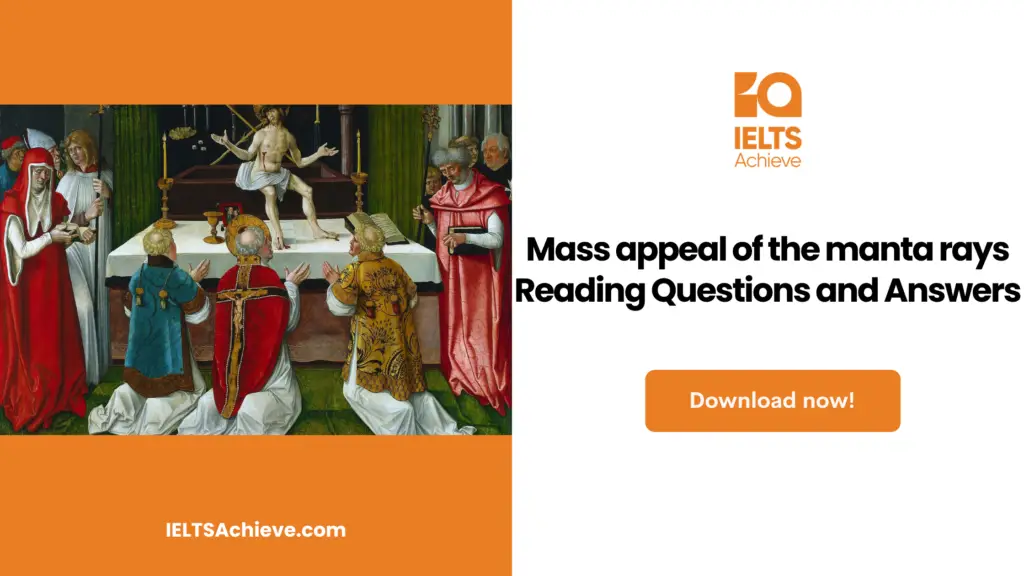The Blog post contains the following IELTS Reading Questions:
- IELTS Reading Sumamry Completion
- IELTS Reading Matching Information
- IELTS Reading True/False/Not Given
Stay informed and prepared for success – Explore our comprehensive Reading Test Info page to get valuable insights, exam format details, and expert tips for mastering the IELTS Reading section.
IELTS Reading Passage – Mass appeal of the manta rays

Mass appeal of the manta rays
A. I am underwater, face to face with a large flat fish which I recognise immediately as being a manta ray. For an instant I look straight into its gaping mouth and see the row of small, flattened teeth in its lower jaw. Close on its tail comes another manta ray, and another and another. The manta rays are unaffected by my being there, cruising past in a leisurely fashion without seeming to expend any great effort.
B. From above, the manta rays are great black silhouettes that fishermen called ‘devil fish’, because of the curious horn-like fins hanging down near their mouths. But looking into their eyes you get a sense of their peaceful nature. Unlike stingrays, mantas don’t have venomous spines in their tails, and unlike many fish species they seem to enjoy human company. Once, over-enthusiastically, I swim towards a manta. I am just a few inches away when it senses me. To my surprise, the whole fish twitches in alarm and shoots off, perhaps fearing that I will touch it. I feel ashamed to have given it a fright.
C. I have come to Hanifaru, a small lagoon next to an uninhabited island in the Maldives, especially to see manta rays. These great harmless creatures congregate here during the south-west monsoons between May and November and, if the tides and winds are right, enter a shallow cul-de-sac in the reef to hunt for plankton, their main source of nutrition. On certain days the bay can attract more than 100 mantas. I have seen many manta rays on dives around the world, though not in these numbers.
D. Guy Stevens is my guide, a British marine biologist who has been studying the mantas for the past five years. Based at the nearby Four Seasons resort, he has identified more than 2,000 individual manta rays, photographing and cataloguing them according to their distinctive skin patterns. Each day we make the 40-minute boat journey from the resort to Hanifaru. Feeding events, as Guy calls them, are never guaranteed, but, during the season, hotel guests can sign up for ‘manta alerts’. If Guy and his research assistants spot significant manta activity, the guests will be brought by fast speedboat to the lagoon to snorkel. When feeding, the mantas of Hanifaru tend to stay near the surface, making them accessible to snorkellers just as much as divers. They seem not to mind the human competition in this quite small space, and indeed they are often joined by other rays and even giant whale sharks, which feed on the same plankton.
E. Word among the diving community about the possibility of finding a mass of manta rays at Hanifaru has slowly been spreading over the past year. Outside the shallow lagoon I can see five large safari boats- live-aboard cruisers that take divers around the best underwater sites in the Maldives. It is something that Guy has been monitoring closely. ‘Word is out that Hanifaru is a top manta spot,’ he explains, ‘and although the government has declared the bay a “protected area”, we still don’t have any regulations in force to limit the number of people in the water at any one time.’
F. During my stay, the resort received a visit from the then-president of the Maldives, Mohamed Nasheed. Since coming to power in 2008, he had made his interest in the marine environment and concerns about climate change well known. In 2009 he held an underwater cabinet meeting, urging other world leaders to act decisively to combat climate change. The protection of wildlife areas such as Hanifaru was clearly one of his objectives, and I asked him why he took such an interest. ‘Maldivians have lived with the reefs and their fish life since long before there were tourists,’ he said. ‘And while tourist dollars are good for our country, the sea and its produce are even more vital to my people. I have to balance what tourists want to see with preserving the marine environment- and in some cases, like Hanifaru, those objectives coincide.’
G. On several dives I am lucky enough to get close to the mantas, sometimes at underwater ‘cleaning stations’. Here, the mantas come in small numbers, or individually, to pause above a coral outcrop and wait while small fish pick at their skin, removing parasites. Adapted for fast swimming with their flattened bodies, they can accelerate rapidly with a twitch of their wings. They gaze at human swimmers with a kind of knowing calm, something people often remark on when they try to capture the emotion they experience after seeing them. ‘The manta rays have the biggest brain of any fish,’ Guy explains, ‘and some manta researchers are convinced that mantas can recognise individual people underwater.’
H. I return to the lagoon over the course of several days and learn more from Guy about his hopes for the future. ‘People can visit this place, but I want to be sure that they don’t harass the mantas by touching them or crowding them out while they’re feeding. We’re working to get a full-time ranger station and some kind of permit system to limit the number of boats that can enter the lagoon each day.’
Unlock your full potential in the IELTS Reading section – Visit our IELTS Reading Practice Question Answer page now!
Recommended Questions:
Renewable Energy IELTS Reading Question with Answer
Questions 28-30
The reading passage has 8 paragraphs, A-H. Which paragraph mentions the following?
Write the correct letter, A-H, in boxes 28-30 on your answer sheet.
28. a record that is being kept of manta rays in the area
29. something that the writer regrets
30. the reason for the writer’s visit
Master the art of matching information and boost your score in the IELTS Reading section. Click here to access our step-by-step guide on handling Matching Information questions effectively.
Questions 31-36
Do the following statements agree with the information given in the reading passage?
In boxes 31-36 on your answer sheet, write
TRUE – if the statement agrees with the information
FALSE – if the statement contradicts the information
NOT GIVEN – if there is no information on this
31. It is difficult to distinguish one manta ray from another.
32. For hotel guests, viewing manta rays feeding has to be arranged at short notice.
33. The manta rays appear to object to the presence of people in the water while they are feeding.
34. Guy Stevens is concerned about the increasing interest in Hanifaru.
35. Mohamed Nasheed succeeded in persuading certain other countries to take steps to protect the environment.
36. A procedure has now been established to control the number of visitors.
Enhance your skills in identifying information as True, False, or Not Given. Click here to discover expert strategies and techniques for mastering this question type in the IELTS Reading section.
Questions 37-40
Complete the summary below.Choose ONE WORD ONLY from the text for each answer.Write your answers in boxes 37-40 on your answer sheet.
The manta ray
During certain times of year, depending on the weather conditions and the tides, manta rays collect to look for 37 ……………….. to feed on. They eat the same food as other species, such as giant whale sharks. As for keeping clean, they are kept free from 38 ……………….. by smaller fish.
Manta rays have certain characteristics which make them good swimmers; they use their 39 ……………….. to get up speed and they have flattened bodies, which help them to move quickly through the water. The nature of the manta’s 40 ……………….. is of particular interest to scientists.
Boost your performance in Summary, Notes, Table, and Flowchart Completion tasks. Click here to explore our detailed guide and learn how to effectively complete summaries, notes, tables, and flowcharts in the IELTS Reading section.
Unlock your full potential in the IELTS Reading section – Visit our IELTS Reading Practice Question Answer page now!
Recommended Questions:
Renewable Energy IELTS Reading Question with Answer
Answer:
28. D
29. B
30. C
31. FALSE
32. TRUE
33. FALSE
34. TRUE
35. NOT GIVEN
36. FALSE
37. plankton
38. parasites
39. wings
40. brain

We hope you found this post useful in helping you to study for the IELTS Test. If you have any questions please let us know in the comments below or on the Facebook page.
The best way to keep up to date with posts like this is to like us on Facebook, then follow us on Instagram and Pinterest. If you need help preparing for the IELTS Test, join the IELTS Achieve Academy and see how we can assist you to achieve your desired band score. We offer an essay correction service, mock exams and online courses.
